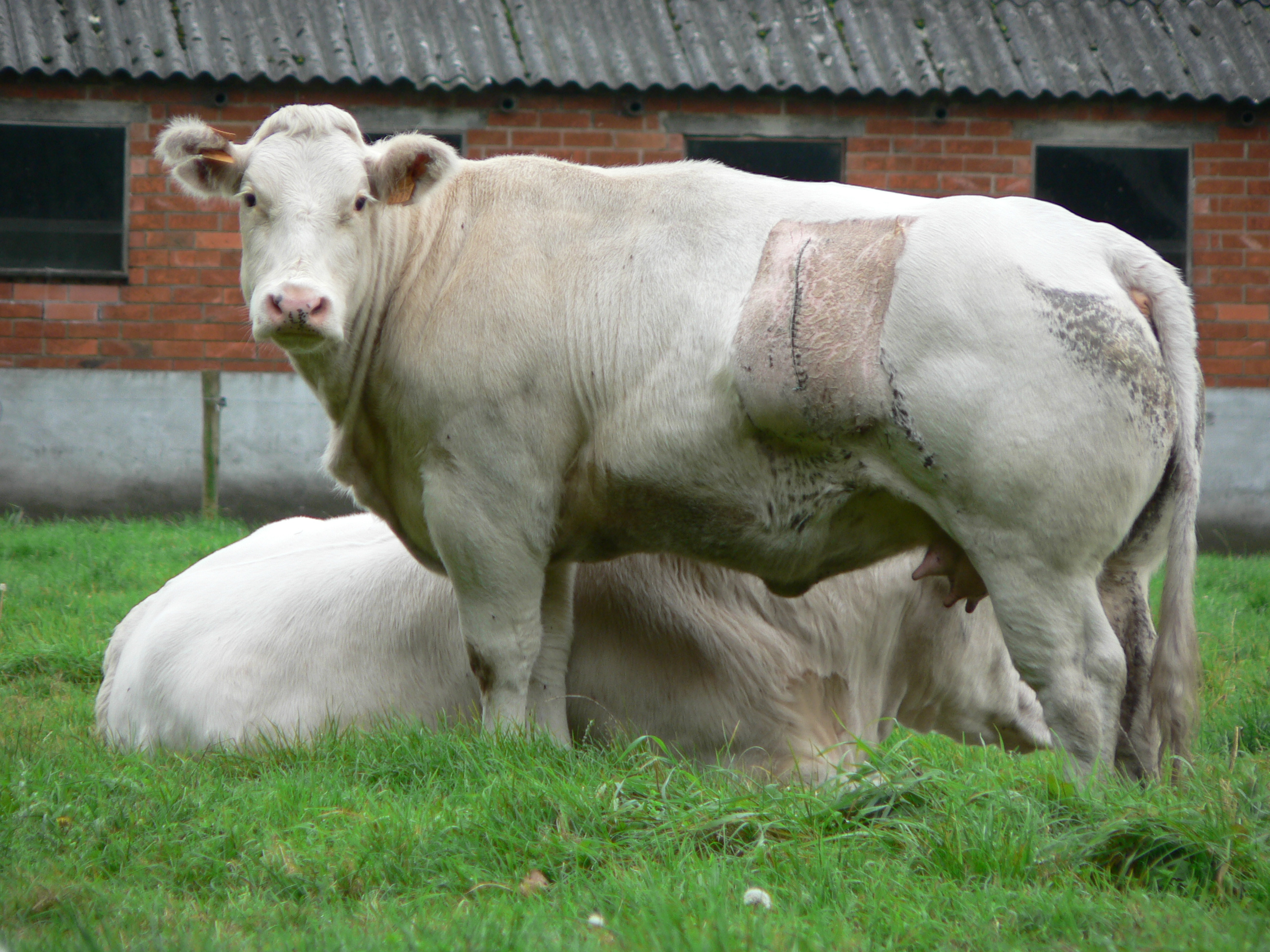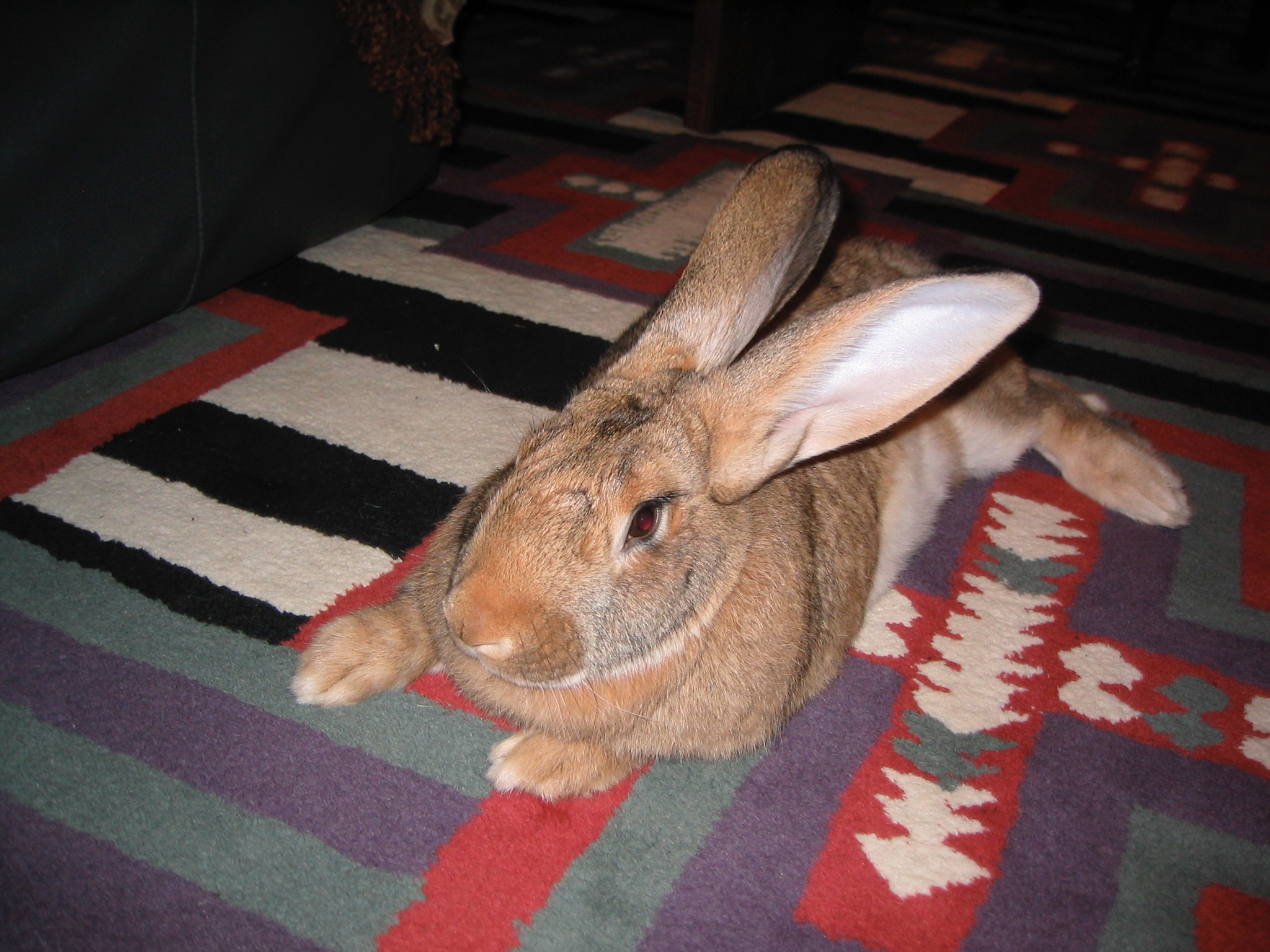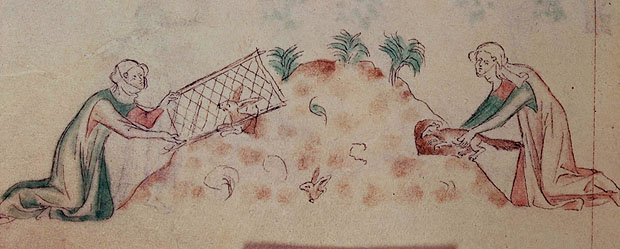|
French Lop
The French Lop is a breed of domestic rabbit developed in France in the 19th century from the selective breeding of English Lop and Flemish Giant stock. The French Lop resembles the English Lop, but the French Lop is heavier in stature and does not have the exaggerated ear length of the English Lop. Weighing approximately 4.98 kg to 5.21 kg, it has an average lifespan of five to seven years. The French Lop is currently recognized by the American Rabbit Breeders Association (ARBA) and by the British Rabbit Council (BRC). History The French Lop was first bred as a meat rabbit, beginning around 1850 in France. It is believed to have been produced by crossing two existing breeds, the English Lop and the Giant Papillon ("géant papillon français" or "Butterfly Rabbit of France"). The new breed became popular in neighbouring countries including the Netherlands, from which ten specimens were exported in 1933 to the UK for exhibition there. By the 1960s, the French Lop had become a ... [...More Info...] [...Related Items...] OR: [Wikipedia] [Google] [Baidu] |
Rabbit
Rabbits, also known as bunnies or bunny rabbits, are small mammals in the family Leporidae (which also contains the hares) of the order Lagomorpha (which also contains the pikas). ''Oryctolagus cuniculus'' includes the European rabbit species and its descendants, the world's 305 breeds of domestic rabbit. ''Sylvilagus'' includes 13 wild rabbit species, among them the seven types of cottontail. The European rabbit, which has been introduced on every continent except Antarctica, is familiar throughout the world as a wild prey animal and as a domesticated form of livestock and pet. With its widespread effect on ecologies and cultures, the rabbit is, in many areas of the world, a part of daily life—as food, clothing, a companion, and a source of artistic inspiration. Although once considered rodents, lagomorphs like rabbits have been discovered to have diverged separately and earlier than their rodent cousins and have a number of traits rodents lack, like two extra ... [...More Info...] [...Related Items...] OR: [Wikipedia] [Google] [Baidu] |
France
France (), officially the French Republic ( ), is a country primarily located in Western Europe. It also comprises of overseas regions and territories in the Americas and the Atlantic, Pacific and Indian Oceans. Its metropolitan area extends from the Rhine to the Atlantic Ocean and from the Mediterranean Sea to the English Channel and the North Sea; overseas territories include French Guiana in South America, Saint Pierre and Miquelon in the North Atlantic, the French West Indies, and many islands in Oceania and the Indian Ocean. Due to its several coastal territories, France has the largest exclusive economic zone in the world. France borders Belgium, Luxembourg, Germany, Switzerland, Monaco, Italy, Andorra, and Spain in continental Europe, as well as the Netherlands, Suriname, and Brazil in the Americas via its overseas territories in French Guiana and Saint Martin. Its eighteen integral regions (five of which are overseas) span a combined area of ... [...More Info...] [...Related Items...] OR: [Wikipedia] [Google] [Baidu] |
Selective Breeding
Selective breeding (also called artificial selection) is the process by which humans use animal breeding and plant breeding to selectively develop particular phenotypic traits (characteristics) by choosing which typically animal or plant males and females will sexually reproduce and have offspring together. Domesticated animals are known as breeds, normally bred by a professional breeder, while domesticated plants are known as varieties, cultigens, cultivars, or breeds. Two purebred animals of different breeds produce a crossbreed, and crossbred plants are called hybrids. Flowers, vegetables and fruit-trees may be bred by amateurs and commercial or non-commercial professionals: major crops are usually the provenance of the professionals. In animal breeding, techniques such as inbreeding, linebreeding, and outcrossing are utilized. In plant breeding, similar methods are used. Charles Darwin discussed how selective breeding had been successful in producing change over ... [...More Info...] [...Related Items...] OR: [Wikipedia] [Google] [Baidu] |
English Lop
The English Lop is a fancy breed of domestic rabbit that was developed in England in the 19th century through selective breeding. It is believed to be the first breed of lop rabbit developed by humans, and it may be one of the oldest breeds of domestic rabbit. Averaging , the English Lop is characterised by its distinctively long lop ears, bold head, and large body size. History As the first lop breed, the English Lop was developed in England in the 19th century for exhibition as an early "fancy" breed—in response to the rising animal fancy of the time. During the Victorian era, the English Lop emerged as a mainstream household pet, marking a departure for such "fancy" breeds from the earlier role of the domesticated rabbit as a source of meat, fur, and wool production. Later, the English Lop was bred with other rabbit breeds from the continent, giving rise to new lop breeds that include the French Lop (from English Lop / Flemish Giant crosses) and the Holland Lop (from Fren ... [...More Info...] [...Related Items...] OR: [Wikipedia] [Google] [Baidu] |
Flemish Giant
Not to be confused with the Continental Giant rabbit The Flemish Giant rabbit is the largest breed of domestic rabbit (''Oryctolagus cuniculus domesticus''). Flemish Giants are historically a utility breed used for their fur and meat. They are often kept as pets as they are known for being docile and patient when being handled. History The Flemish Giant originated in Flanders. It was bred as early as the 16th century near the city of Ghent, Belgium. It is believed to have descended from a number of meat and fur breeds, possibly including the ("Stone Rabbit"—referring to the old Belgian weight size of one stone or about ) and the European "Patagonian" breed (now extinct). This "Patagonian" rabbit, a large breed that was once bred in Belgium and France, was not the same as the Patagonian rabbit of Argentina (''Sylvilagus brasiliensis''), a wild species of a different genus weighing less than , nor the Patagonian mara (''Dolichotis patagonum''), sometimes called the Patagonian h ... [...More Info...] [...Related Items...] OR: [Wikipedia] [Google] [Baidu] |
American Rabbit Breeders Association
The American Rabbit Breeders Association (ARBA) is a national club for domestic rabbit and cavy breeders. The ARBA is headquartered in Knox, Pennsylvania in the United States. Its membership is composed of rabbit and cavy breeders throughout, fanciers, and pet owners in North America and many countries throughout the world. The ARBA serves to promote the domestic rabbit and cavy fancy, as well as commercial rabbit production. The American Rabbit Breeders Association sets official breed standards for recognized rabbit breeds and cavy breeds. Every five years the ARBA publishes a detailed guide entitled ''Standard of Perfection''. This guide is beneficial to rabbit and cavy ( guinea pig) breeders, providing a reference to those interested in understanding the conformation standard for the variety of breeds recognized by the ARBA. ARBA recognizes 50 breeds of rabbit and 13 cavy breeds. Rabbit shows The ARBA sanctions rabbit shows throughout the year, all over the USA and Ca ... [...More Info...] [...Related Items...] OR: [Wikipedia] [Google] [Baidu] |
British Rabbit Council
The British Rabbit Council (BRC) is an organisation for rabbit enthusiasts in the United Kingdom. Rabbits are the UK's third most popular pet. History The British Rabbit Council was formed in 1934 when the British Rabbit Society and the National Rabbit Council of Great Britain and her Dominions merged. Recognised breeds There are over 50 breeds recognised by the British Rabbit Council and over 500 varieties. These are divided into four groups – Fancy, Lop, Normal Fur, Rex. Structure To enter most rabbit shows, participants must be Council members and their rabbits must have a metal ring around one hind leg registered in their name. In breed classes, the rabbits are judged to a standard. See also * American Rabbit Breeders Association * List of rabbit breeds As of 2017, there were at least 305 breeds of domestic rabbit in 70 countries around the world. A rabbit breed is a distinct variety created through selective breeding (or occasionally natural selection) for speci ... [...More Info...] [...Related Items...] OR: [Wikipedia] [Google] [Baidu] |
Checkered Giant
The Checkered Giant, known as ''Géant Papillon'' in French, is a breed of domestic rabbit that originated in France. One of the largest rabbit breeds, the Checkered Giant is recognized by the American Rabbit Breeders Association (ARBA). The Checkered Giant is one of the minority of rabbit breeds with specific coat markings. The markings defined in the breed standard of the Checkered Giant differ somewhat from those in the breed standard of the Giant Papillon. For ARBA show purposes, a mature Checkered Giant buck must weigh a minimum of , and a mature doe must weigh a minimum of . ARBA does not specify a maximum weight for Checkered Giants. History In 1904, Otto Reinhardt of Reinfalz, Germany interbread the Great German Spot and black Flemish Giant rabbit. Six years later, the Checkered Giant was introduced in the United States. Appearance For the Checkered Giant, ARBA recognizes two varieties: Black ("white with black markings"), and Blue ("white with gray markings"). Each ... [...More Info...] [...Related Items...] OR: [Wikipedia] [Google] [Baidu] |
Domestic Rabbit
A domestic or domesticated rabbit (''Oryctolagus cuniculus domesticus'')—more commonly known as a pet rabbit, bunny, bun, or bunny rabbit—is a subspecies of European rabbit, a member of the lagomorph family. A male rabbit is known as a ''buck,'' a female is a ''doe,'' and a young rabbit is a ''kit'', or ''kitten''. Rabbits were first used for their food and fur by the Romans, and have been kept as pets in Western nations since the 19th century. Rabbits can be housed in exercise pens, but free roaming without any boundaries in a rabbit-proofed space has become popularized on social media in recent years. Beginning in the 1980s, the idea of the domestic rabbit as a house companion, a so-called ''house rabbit'' similar to a house cat, was promoted. Rabbits can be litter box-trained and taught to come when called, but they require exercise and can damage a house that has not been "rabbit proofed" based on their innate need to chew. Accidental interactions between pet rab ... [...More Info...] [...Related Items...] OR: [Wikipedia] [Google] [Baidu] |
List Of Rabbit Breeds
As of 2017, there were at least 305 breeds of domestic rabbit in 70 countries around the world. A rabbit breed is a distinct variety created through selective breeding (or occasionally natural selection) for specific characteristics, including size, fur (length, quality, or color), feed conversion ratio, climate adaptability, or temperament. Groups such as the American Rabbit Breeders Association (ARBA) and the British Rabbit Council (BRC) coordinate and standardize the desired qualities of their recognized breeds, through promotion and exhibition. Each rabbit breed is considered to benefit when a reputable breeder strives to emulate the purpose for the breed, often defined by the individual breed standard by which it may be judged. The global diversity of breeds reflects the breadth of the rabbit's unique qualities. Listed below are 191 of the world's modern-day rabbit breeds. Modern-day rabbit breeds * indicates "Rabbits in COUNTRY or TERRITORY" links. Scope Th ... [...More Info...] [...Related Items...] OR: [Wikipedia] [Google] [Baidu] |
Lop Rabbit
Lop rabbit or lop-eared rabbit refers to any rabbit with ears that droop, as opposed to being carried erect. A number of rabbit breeds (listed below) are characterized by such lop ears. Abnormalities in the skull of a half-lop rabbit were studied by Charles Darwin in 1868. Ear carriage The defining feature of the lop rabbit is its ear carriage. Unlike the erect ear of the majority of domestic rabbit breeds, lop breeds have ears loosely drooping, with the opening of the ear facing the skull. Due to the slightly-raised cartilaginous ear base, the head of many lop rabbits (with the exception of English Lops) has a small bulge, referred to as the ''crown''. The head of a typical lop rabbit is said to resemble that of a male sheep in profile, thus the German term for a lop rabbit ''(Widder,'' meaning ''Aries he ram'', the French term ''(bélier,'' meaning ''ram'') and the Italian term (''ariete'', from Latin ''aries''). A rabbit's ear, with its blood vessels close to the surfa ... [...More Info...] [...Related Items...] OR: [Wikipedia] [Google] [Baidu] |
.jpg)




